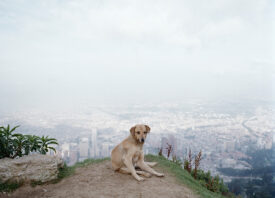Search this site
10 Mistakes Photographers Make When Listing Their First NFT

The NFT space evolves so rapidly that it’s said one month feels like a year. Another popular saying is that collectors and artists are “building the plane while flying,” making decisions on the go that could influence the market for years to come. And given that breakneck pace, mistakes do happen.
Artists have been scammed by people claiming to be collectors interested in purchasing work, having money and assets stolen from their wallets. Some have priced their work too high and struggled to find buyers. Others priced photos too low.
“People see NFTs selling, and they think it’s easy,” the photographer Paola Franqui, who also goes by the moniker Monaris, admits. “No, it’s a lot of work.” In Web 2.0, she was already established. She has more than 350K followers on Instagram, with a client list that includes Mercedes Benz, Nike, and American Airlines. Her debut book was published by Setanta Books.
“I had to start over in Web3,” she says. “Most collectors had no idea about my work. But now I’m 100% invested in this space. It has changed my life.” We asked five prominent photographers in the community to tell us about some of the common mistakes they see photographers making when minting their first NFTs–and how they can be avoided.
Mistake #1: Not being active on Twitter.
The NFT community lives and breathes on Twitter. “It’s all extremely fast-paced and ever-evolving, so you first must be willing to listen and absorb,” the photographer Gabriella Morton explains. “Ads and influencer marketing stick out as inauthentic, so you really need an organic, consistent presence to be recognizable and identifiable.” Collectors will often look at an artist’s Twitter feed not only to gauge their work but also to learn their backstories—and see whether or not they’re sharing work by other artists and uplifting their peers.
To learn more about the role of Twitter in the space, check out our article on the subject.
Mistake #2: Jumping in without getting to know the community.
Beyond Twitter, consider attending events, virtual and in-person, or linking up with people in your city. Sit back and listen to what people in the community have to say before jumping in yourself. “I learned, built products, wrote articles, hosted talks, and so on for ten months before I dropped my collection, DRIVE,” the photographer Dave Krugman says. “If you add value before you ask for value, you’ll never have to ask.
“Learn, participate, and contribute. We are in interconnected digital ecosystems; focus on the health of the whole forest, not just your tree. We all need each other. Help us build; help others, and you will ride the wave with all of us. By the time I dropped DRIVE, everyone was eager to own a piece from me because I had already proven I was here for the long run.”
Mistake #3: Minting everything.
“Photographers need to approach the NFT space with intention and curate the work they intend to mint on the blockchain more aggressively than they normally would,” the artist Aaron Ricketts tells us. “One reason is because almost every interaction on the blockchain has an associated gas fee, which could get expensive very quickly if you are constantly minting or burning work.” Start with just a few pieces, and if they sell, try more.
Mistake #4: Undervaluing your work.
The NFT space–and its price points–can be wildly different from the traditional art world, so it’s good practice to research the market and the players in the community to get a feel for demand and pricing. The more scarce or rare your work is, in general, the higher you can price it. A 1:1 photo will be worth more, for example, than a larger edition.
“Looking back on my first collection, Collecting Hands, I sold those photos for 0.3 ETH,” Monaris remembers. “Now, that hurts me. That’s painful.” For context, the floor price for the collection is 2.25 ETH, as of this writing. The total trading volume is 39.9 ETH. “At the same time, maybe everything happened the way that it had to happen,” the artist says. “That collection helped me spread the word of who I was–and who I am in Web3.” Given the demand, her subsequent collections have started off at higher price points.
Mistake #5: Starting with unrealistic prices.
On the other side of the coin, it’s usually better to start low and then increase your prices over time. “When you begin, maybe save your absolute best work for later, but put things out you are very proud of at reasonable prices,” Krugman suggests. “The goal is to start building your collector base–your group of invested advocates. From there, you can scale up, iterate, and learn. The key to this space is participation, so it’s best to get started and learn as you go.”
Mistake #6: Expecting immediate results.
“The biggest mistake I see in the space is rushing in and burning out, or giving up because you don’t make a sale right away,” Krugman adds. “I’ve had SuperRare pieces sit for months with no interest, before selling for 8.5+ ETH later.” In other words, think long-term. Continue engaging with the community, sharing your work, and supporting other artists. Success comes with time and patience.
Mistake #7: Letting the market control your vision.
While it’s important to understand what’s trending in the space, that doesn’t mean you have to change your work to fit what you think other people want to see. Many of the most successful artists in the space have spent years–a decade, in some cases–creating and innovating before finding a home for their work on the blockchain.
It might be tempting to change your style to match other successful artists, and it might lead to a quick sale, but it won’t do anything to foster those long-term relationships that drive this space. On the other hand, doing something original can pay off.
“Some artists have come in taking risks and had great success trying something different,” Jessica Cardelucci tells us. “For example, when I minted my Wild Mustangs collection last summer, there were hardly any still B&W collections on the blockchain and also very few images of wildlife. It took a while to get some traction, but I’ve since had a 7 ETH secondary sale, which was extremely humbling for my photography.”
Mistake #8: Not being safe.
The crypto art space is, unfortunately, riddled with scams and hackers. Basic safety measures include using two-factor authentication (2FA) on all your accounts, setting up a cold storage hardware wallet (like a Ledger), never clicking on links from people you don’t know, and never, ever sharing your private key or your recovery/seed phrase.
“Get a physical hardware crypto wallet if you can afford one before getting started,” Cardelucci advises. “There are sadly lots of opportunities for user errors in this industry, so I highly recommend researching how to keep your assets safe. Learning more about crypto security is also key. I know it’s a lot to absorb, but it will be helpful in the long run if you want to stay in this space.”
Mistake #9: Ignoring your carbon footprint.
“Although most don’t consider the energy consumption of traditional banking, social media, and the making/shipping/packing of physical art, we do need to acknowledge that NFTs have a footprint,” Morton admits. “When you calculate the dollar average, it’s by far more sustainable to sell high-value 1/1 NFTs than lower-value, quantifiable editions.” The energy-intensive protocol that currently powers the Ethereum blockchain, where most NFTs live, could change soon, but in the meantime, it’s worth doing everything you can to understand, quantify, and reduce your emissions.
Mistake #10: Seeing the “sale” as the end goal.
“The biggest mistake you can make is dropping a project and then walking away,” Krugman tells us. “A project launch is the start of a journey–the sale is the entrance, not the exit. If you are lucky enough to sell out a project, make sure you have a plan to keep that community engaged, and even before that, make sure that’s something you really want to do. Working in NFTs as an artist is more than a full-time job; it’s an all-consuming lifestyle with the goal of becoming a sovereign individual. To me, the effort is worth it–to own my time, have control of my art, and have the resources to make my wildest ideas a reality.”



